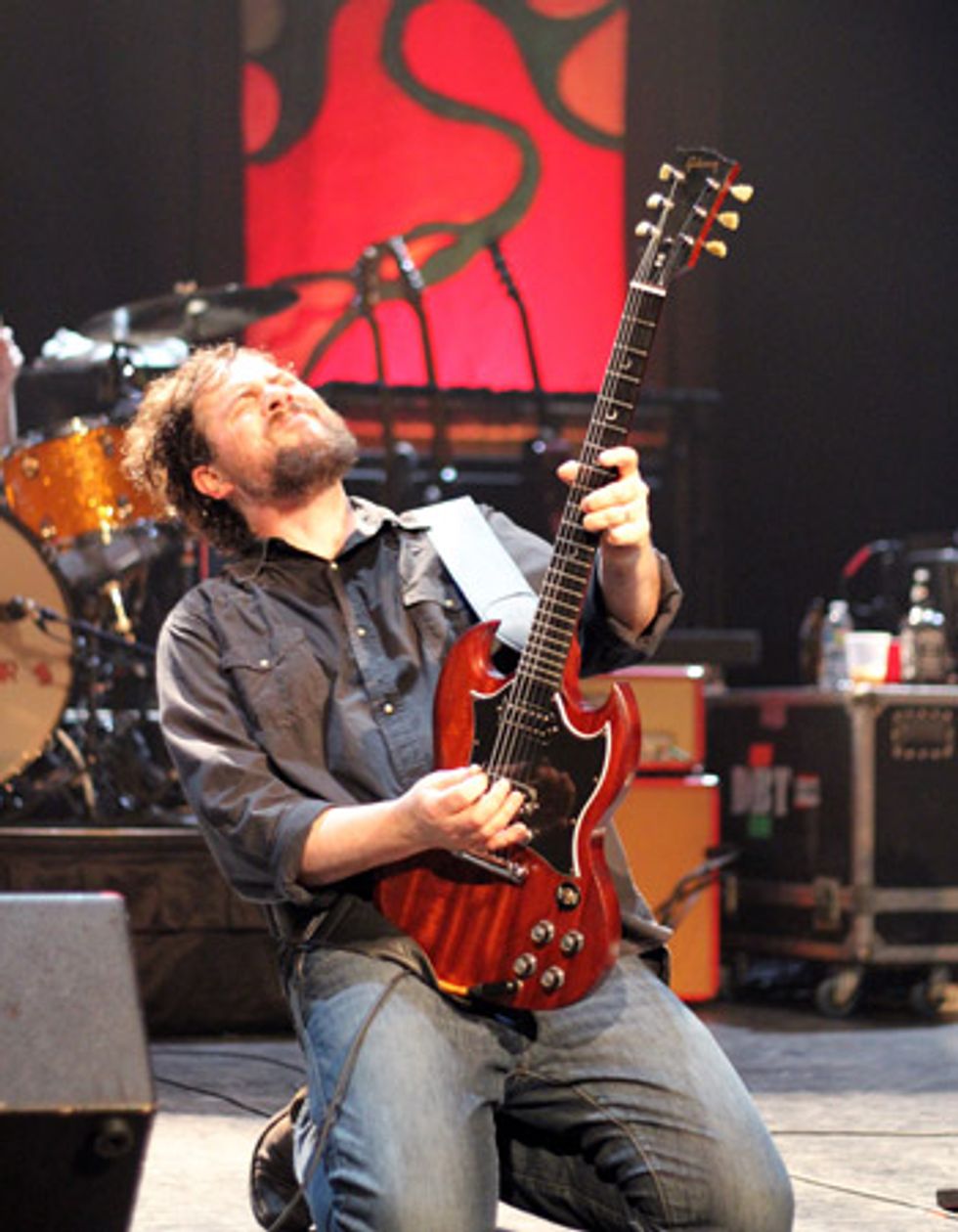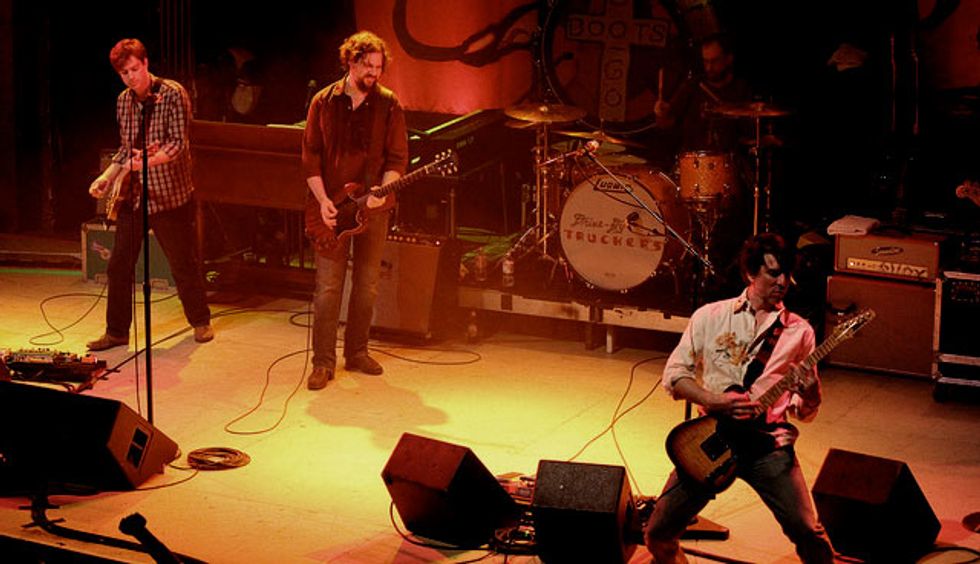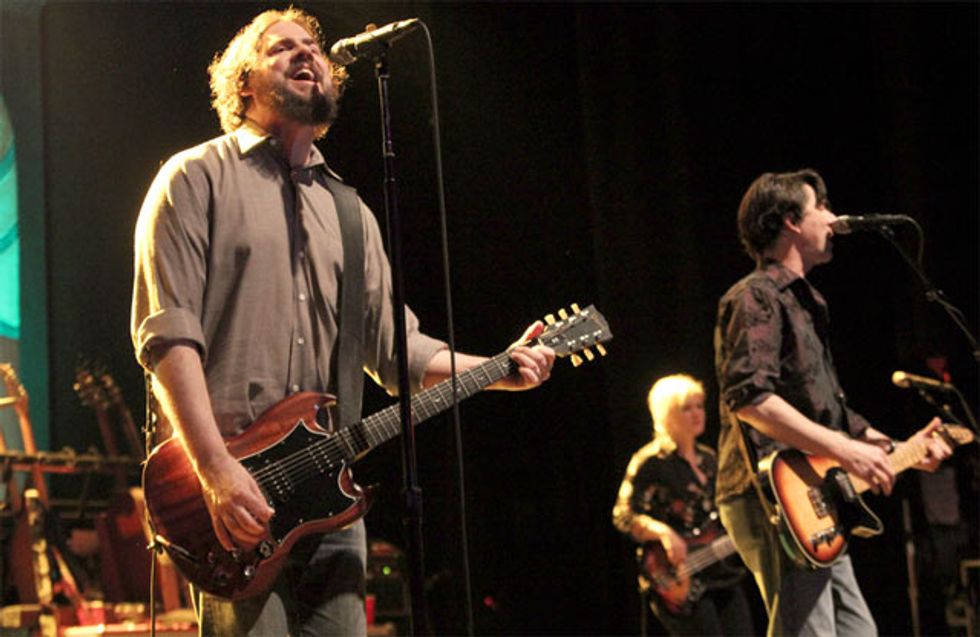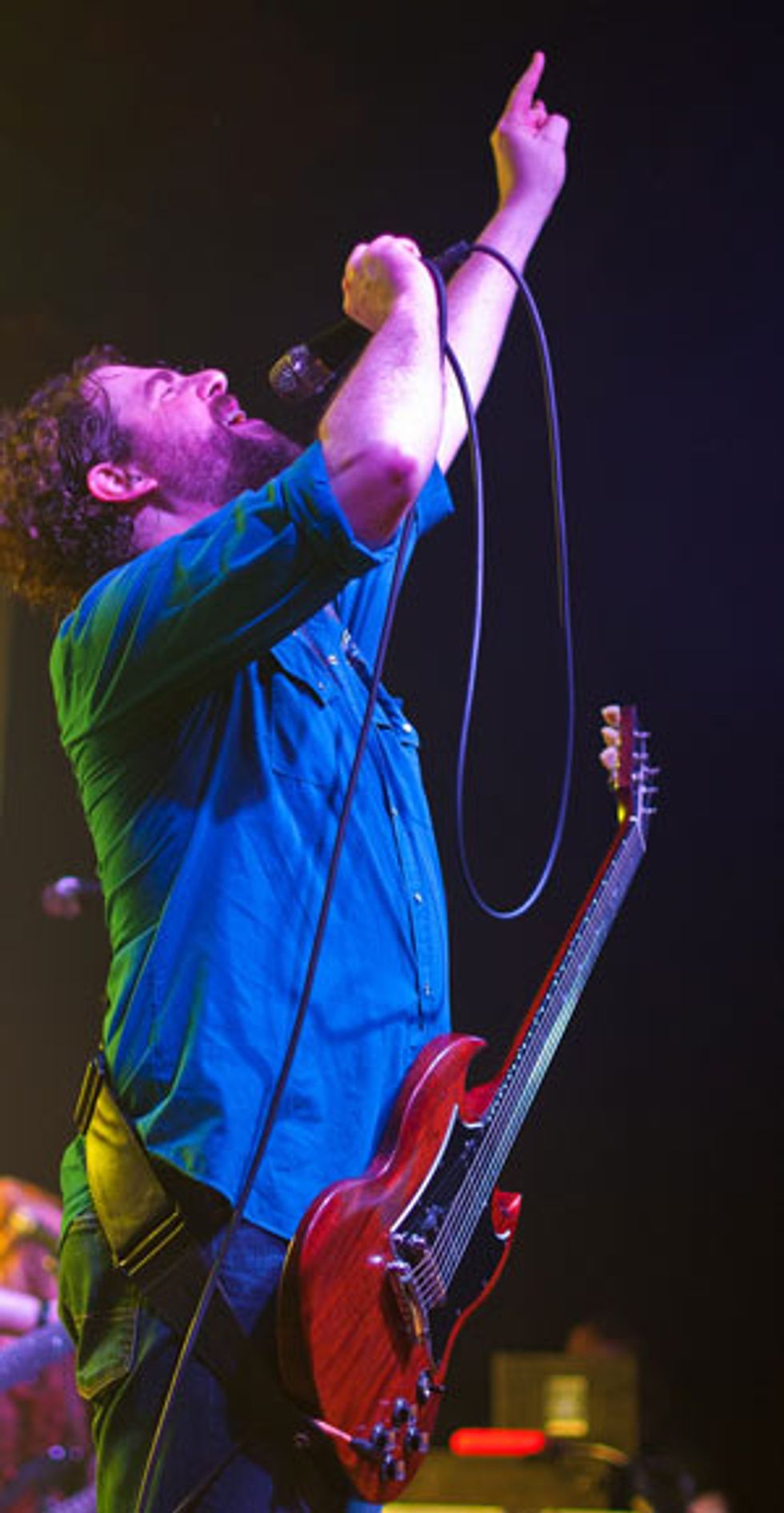 Patterson Hood gets down and digs into his Gibson SG Special at a February 16, 2011 show at Penn State York University's Pullo Center. Photo by Adam Chlan. |
Perhaps that’s why the feel of the band’s latest release, Go Go Boots, was so unexpected. Quieter and more reflective than previous efforts, the high-flying leads are traded in for tender shuffles and haunting slide work, courtesy of fellow Truckers Mike Cooley and John Neff. A dose of Muscle Shoals soul—the music of Hood’s upbringing—is added for good measure. But gone is the Goldtop, replaced by a stripped-down SG and a parlor-sized Baxendale acoustic.
Of course, you can’t mess with success too much. Distorted guitars still lurk in the corners of the mix, and Hood continues to weave together characters full of bad thoughts and worse decisions—though it’s apparent the band learned a few things from recent side projects backing R&B luminaries like Bettye LaVette and Booker T. Go Go Boots largely leaves the hard rock behind, and still manages to groove in a way that we haven’t heard before—a remarkable accomplishment for a band that has been together for over 20 years and put out close to a dozen full-length records.
You wrote in a letter to fans, “If The Big To-Do was an action adventure summertime flick (albeit with some brainy and dark undercurrents), this album is a noir film.” Go Go Boots definitely sounds different in tone and style, but the tracks for both albums were recorded around the same time. Did you know how you wanted the tracks to be split up as you went into those sessions?
Yeah, pretty much. We had a pretty specific record and sound we wanted to make with The Big To-Do, but we had these other songs that didn’t quite fit. We still felt really strongly about them, so we decided to go ahead and record everything—and just kind of separated them out.
We knew early on while cutting songs that they would be on the second record. It was actually kind of fun working that way, because it enabled us to take a longer amount of time on the record—more than we’ve ever really had the ability to take before. Last year, whenever we had time off from the road, we’d go in and just kind of piddle with it—working with it for awhile at a pretty leisurely pace. I think it suited this type of record a lot.
Go Go Boots is certainly a lot more laid back than its predecessors, and has a lot more of that Southern soul vibe. Is that a by-product of growing up in the Shoals of Alabama?
Certainly. This record definitely addresses the music of our upbringing in a more direct way than we ever have before. That’s something that we’ve always wanted to do, but it’s really just now that we’ve gotten to a place where we can do the music justice. There are elements as far back as our first record—a song like “Sandwiches for the Road” probably would have fit really well on this record. But it takes a certain amount of discipline as a player to be able to really give that music justice.
We were also influenced by the side projects we’ve done. While working on the Bettye LaVette record [2007’s The Scene of the Crime], we kind of had to learn a new way of playing in order to do that record. Likewise, when we did the record with Booker T. [2009’s Potato Hole], we learned so much from him, even with the really brief period of time we had. It was like a graduate level course in song construction.
A big part of this album’s beauty is the grooves that you guys fall into—it seems effortless for a lot of the record. You and Mike Cooley have been together forever. How have you guys grown together as musicians in that time?
I love playing with him. We’ve played together for 26 years, and didn’t get along for many of them. We actually get along great now, but the first 10 or so it was pretty rough going a lot of the time, and it can still turn on a dime. [laughs.]
Does that tension make for better music?
It’s not a bad kind of tension. We obviously have a lot of respect for each other— otherwise it wouldn’t work. We’re just both very strong personalities, and we’re about as different as could be, but we have a huge respect for the differences because we’ve realized that it makes us a better band. And at the end of the day, I love his songs and I love what he brings to the table on my songs. His playing is very—I won’t say undisciplined, because he’s an extremely great player—but he plays with a certain wild abandon and bravado that I find very appealing to the songs that I write.
It also makes for a really nice contrast having John Neff on one side and Cooley on the other. Neff is an extremely tasteful and disciplined player, and the two of them really never clash musically. It’s pretty amazing how well they play together—because they both bring such different things to the table—and I really consider myself lucky that I get to stand between them.

Hood (center) and Neff (left) hang back while Cooley (right) takes a solo at a March 18, 2011 show in Denver, Colorado. Photo by Michael Bialas.

“Everybody Needs Love” is a great cover of the classic Eddie Hinton song—another Muscle Shoals alum. I understand it was originally recorded for a Hinton tribute 45?
Yeah, there is a little record store in Cincinnati, Ohio, and the guy who owns it is a huge Eddie Hinton fan. He wanted to do a series of 45s paying tribute to Hinton, with other people recording his songs. We were asked to do the second record in the series and recorded it around the same time we had studio time booked for our record. It kind of reshaped Go Go Boots—for lack of a better way of putting it—by helping us find something we were looking for on the record. Including “Everybody Needs Love” and “Where’s Eddie” (another Hinton track) on the album was a huge inspiration in writing and recording the first and last song, “I Do Believe” and “Mercy Buckets.” Those songs probably wouldn’t have been on the record had we not done Eddie Hinton’s songs.
The Hinton songs seem like these small moments of joy on an album otherwise filled with darker themes.
I kind of feel the same way about “I Do Believe,” and “Mercy Buckets,” as far as being the counterpoint to the darker elements on the record, and it sort of became part of the unintended theme of the record. To have these different characters, some of them obviously being misguided and doing destructive or bad things, and then have this other thing in there that’s more positive—someone maybe finding the light. In all of those songs, the redemption comes through a kind of lasting love. It sounds trite and cliché to say love is the answer, but maybe it really is.
Are you into the tone and gear sides of the music, or do you just like to grab a guitar and go?
I’m very much into tone, but I like finding it in the simplest way possible. I won’t say it’s due to laziness, but I don’t play a lot of notes. I gravitate towards as few notes as possible to present the melody that I hear, so I want each of those notes to really sound good. It’s probably something I’ve searched for as long as I’ve played. In recent years I feel like I’ve kind of found my sound, and I’m very happy with that. And I’ve found it in a pretty simple way with a tube amp, a speaker, and maybe one pedal—maybe not.
What amp did you go with on the album?
I’m mostly playing through a ’72 Fender Deluxe Reverb, and that’s been sort of my amp of choice for a while. It’s nice in the studio because it’s not so big, and you can turn it up and get it to break up just right. There’s really no need to have a huge amp in the studio. I also played a ’66 Deluxe Reverb blackface reissue that I got around the time of my solo album, Murdering Oscar, and also played through it on A Blessing and a Curse.
There are probably also a couple songs where I’m playing through one of [longtime DBT producer] David Barbe’s Ampegs. He’s got a bunch of really cool vintage Ampegs around the studio, and at any given time he might swap them out to see how it sounds. A lot of times, unless there’s something specific in my head, we’ll leave it to him. He knows what’s going on the tape and how it plays with the other stuff.
Fans are pretty familiar with your ’69 Goldtop, known as Estelle. Is that what we’re hearing on the record?
On this record I’m mostly playing my SG. It’s like the cheapest Gibson SG you can get without being an Epiphone. It’s unfinished—just brown. I got that around 2003’s Decoration Day, but started playing my Goldtop around 2005. I switched back to the SG about a year and a half ago when we were working on this record, because I was liking the sound better for what I was doing.
What did you hear in the SG that made you switch back?
I just like where it breaks up. I can make it sound really clean or really dirty without touching a knob, only by attacking the strings. It’s just a good guitar.
Is the SG tuned down?
Part of the sound we get is from tuning down a step, but the SG is tuned standard. At any given time, there’s probably going to be one person tuned standard, one person tuned down and someone else going one way or the other. We use all kinds of different tunings with all of these guitar players—it keeps everybody’s sound different.
It sounds like there’s more acoustic on this album as well.
Yeah, there probably is. I’ve got a custom-made acoustic from a guy named Scott Baxendale, who relocated to Athens about a year ago. He’s an incredible master luthier, and built me the guitar a few years ago. I just love that guitar—it’s a smaller parlor-style acoustic, but it has a little bit longer neck scale to accommodate my tuning. He studied video of me playing, and tailored the neck and everything else around what he saw. The first time I picked it up, it was the most amazing playing guitar I had ever played. So I’m playing that pretty much anytime there’s an acoustic.
I also have an old Craftsman acoustic, but I have no idea how old it is. Scott rebuilt it by re-bracing it, straightening out the neck and putting new tuning pegs on it—it’s a really cool guitar. And it really records well—it’s got a cool sound when you put a mic in front of it. It kind of cuts in a different place than any other guitar I’ve got. I’m playing that on the song “Santa Fe” on The Big To-Do.
 Hood takes a break from riffing on the SG to belt out some notes at a January 2011 show in Tampa, Florida. Photo: Ian M. Ireland. |
I like the warmth of it. I love the way it kind of distorts and breaks up a little bit when you hit it hard. You can smash that snare drum a little and get a sound that you just don’t get with digital, because digital’s so clean and perfect. Sometimes if you turn up that snare a little to where it smashes against the tape, it becomes part of the sound.
You guys also maintain a pretty hectic touring schedule, meaning you play a lot of backline gear. What kind of amps are you playing on the road these days?
I’m playing a Fender Vibro-King from the Fender Custom Shop. It’s a bigger amp with three 10s, and I’ve been playing that for about a year. I stumbled onto one last summer when we were playing a festival in Europe—that’s what they had for me in the backline instead of what I had asked for—but I fell in love with it. I came home and ordered one the day I got back, and that’s been my live amp ever since.
What’s your pedalboard look like?
I don’t have a lot of effects. I’ve got a Boss DS-1 Distortion, which is probably the one I use the most, and a tap tempo delay, which I usually use one to two songs a night. I use a phase shifter one song a night on Cooley’s “Birthday Boy,” although I didn’t use it on the record. I also have an Electro-Harmonix Holy Stain, and I used it on “The Flying Walindas” on The Big To-Do, although I don’t use it live anymore. A lot of times for what I do, it works best to keep things pretty simple.
Patterson Hood's Gear Box
Patterson Hood uses mostly vintage and analog equipment. He uses D’Addario strings. All cables are Rapco Horizon.
Acoustic:
(Main) Baxendale Harwood - 12-fret, ebony fretboard, koa back and sides, spruce top
(2nd) Kay Craftsman - 14-fret ebony fretboard, mahogany back and sides, spruce top This has gone through Scott Baxendale’s “Harmony Conversion” process, which consists of resetting and refretting the neck, removing the back and replacing all the braces with Baxendale’s bracing pattern, and finishing with a new bridge saddle nut and tuners.
(Mando) Kay Uku/Mandocello - 14-fret ebony fretboard, maple back and sides, spruce top. This is a parlor guitar converted into a mandolin using the Baxendale “Harmony Conversion” process with a little added twist. Says tech Damon Scott, "As well as the standards of a 'Harmony Conversion,' I rebraced it a little heavier, then cut a bridge and nut for double courses of four and replaced old tuners with new mandolin tuners."
All acoustics use Fishman Acoustic Matrix Natural II through an Ampeg SVTDI tube DI. Patterson plays .013 Phosphor Bronze strings.
Electrics:
(Main) Gibson ’68 Les Paul Deluxe Goldtop with Mini Humbuckers
(Main) Gibson SG Special
Baxendale Archtop semi-hollowbody with Bigsby and Seymour Duncan Antiquitys
Gibson SG Standard
Gibson Les Paul Goldtop Reissue with Seymour Duncan Antiquity II Mini-Humbuckers
Reverend Warhawk with Les Trem
Epiphone Firebird electric mandolin
All electrics use Seymour Duncan pickups when not stock. Patterson plays .011 nickel wound strings.
Amps:
Gibson Skylark (Mostly used for acoustic solo shows and in studio)
Ampeg Jet (Used for in-stores, solo shows, and as a C amp on stage)
Fender Tube Reverb (This and the ’75 Deluxe are main rig)
’75 Fender Deluxe Reverb (Stock, except for swap of Jensen C12k speakers)
Fender ’64 Deluxe Reverb Reissue (modded to 40-watts, blackface Vibroverb circuit, Class A)
’76 Fender Twin Reverb (moded to class A)
Fender Vibro-King (Patterson’s main backline amp)
Ampeg Gemini I (David Barbe’s amp used in the studio)
All repairs maintenance and mods by Steve Hunter at Thee Electrick Church. Athens, Ga.
Effects:
PedalTrain 2 pedalboard
Voodoo Lab Pedal Power 2 Plus
Boss TU-2 Tuner
Boss GE-7 Graphic Equalizer
Boss SD-1 Super OverDrive
Roland RE-20 Space Echo
Seymour Duncan STX-01 Pickup Booster
Electro-Harmonix Holy Stain
Electro-Harmonix Small Stone
RapcoHorizon A-B-Y
All cable looms are made by tech Damon Scott using many supplies from RapcoHorizon.













![Rig Rundown: Russian Circles’ Mike Sullivan [2025]](https://www.premierguitar.com/media-library/youtube.jpg?id=62303631&width=1245&height=700&quality=70&coordinates=0%2C0%2C0%2C0)
















![Rig Rundown: AFI [2025]](https://www.premierguitar.com/media-library/youtube.jpg?id=62064741&width=1245&height=700&quality=70&coordinates=0%2C0%2C0%2C0)




















 Zach loves his Sovtek Mig 60 head, which he plays through a cab he built himself at a pipe-organ shop in Denver. Every glue joint is lined with thin leather for maximum air tightness, and it’s stocked with Celestion G12M Greenback speakers.
Zach loves his Sovtek Mig 60 head, which he plays through a cab he built himself at a pipe-organ shop in Denver. Every glue joint is lined with thin leather for maximum air tightness, and it’s stocked with Celestion G12M Greenback speakers.






